Embarking on a Sumatra backpacking trip is one of those decisions you’ll look back on and think, “I’m so glad I did that”. Despite being Indonesia’s largest island, Sumatra is very much off the typical tourist map in southeast Asia.
That means a few things, the first one being that you won’t be jostling with other tourists for views or hikes. Instead, it’s very likely that you may be the only one trekking the Mount Sibayak volcano at sunrise or looking over the rice terraces bowl in the Harau Valley.
Two: it’s easier to have more authentic cultural experiences, whether that’s living with the Mentawai tribe on a remote Indonesian island, following a trail mapped out by local teenagers, or cooking Indonesian cuisine at your homestay after spending two days in the jungle in pursuit of seeing Sumatran orangutans.
The third point is the most important, however: putting together a Sumatra itinerary is not a walk in the park. There is no standard backing route in Sumatra… yet.
If there was one thing I could have wished for during my time travelling Sumatra, it would have been an in-depth Sumatra blog. And I don’t just mean a north Sumatra itinerary, but a west Sumatra itinerary too.
Sumatra doesn’t only provide the chance to explore an offbeat travel destination away from the typical Indonesia tourist track. It is also one of only two destinations in the world with orangutans.
It also has the largest crater lake in the world. Volcanoes, canyons, valleys, remote islands, traditional architecture, and authentic Indonesian food are just a handful of the reasons why you should visit Sumatra.
Any backpacking guide would fall short at only providing the best destinations to visit.
My guide, along with my other detailed Sumatra blog posts, covers the practical aspects of travel in Sumatra, such as how to get around, where to stay, seasons to avoid, and what to wear in Sumatra.
Where is Sumatra?
Sumatra is in Indonesia, an archipelago with over 17,000 islands and islets – that’s even more islands and islets than in the the Philippines.
Sumatra is part of southeast Asia, which has a popular backpacking trail. It’s adjacent to mainland Malaysia and north of the Indonesian island of Java. Further south, Bali sits at the southern end of Java.
QUICK INFORMATION
Best time to visit: April to May
Flights to Medan: AirAsia
Best site for Sumatra accommodation: Booking.com
Why is Sumatra famous?
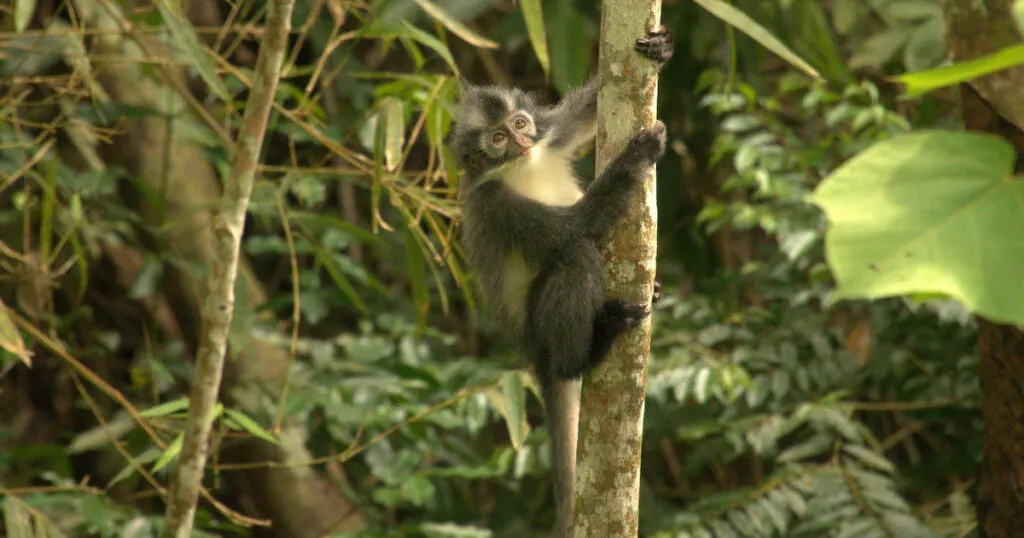
- Sumatra is one of only two islands in the world with orangutans (the other is Borneo).
- It has the world’s largest crater lake, Lake Toba.
- It is the sixth-largest island in the world.
- It has some of the most important and unique rainforests in the world, which are home to important species such as Sumatran tigers, rhinos, elephants, gibbons and sun bears. Many of the species are native to the island (only found in Sumatra).
- Sumatra is an offbeat travel destination in Indonesia: you don’t need to compete with backpacker crowds and you can experience more authentic interactions with locals.
- It is the third-largest coffee producer in the world. You must try Sumatran coffee.
- There are 10 national parks in Sumatra.
- Sumatra features distinct traditional houses called Rumah Gadan, which feature gabled concave roofs inspired by the shape of buffalo horns.
- Sumatra is located on the Ring of Fire. Therefore, it is famous for having 68 volcanoes and having experienced past eruptions and other natural disasters.
Backpacking Sumatra: Is it worth going to Sumatra?
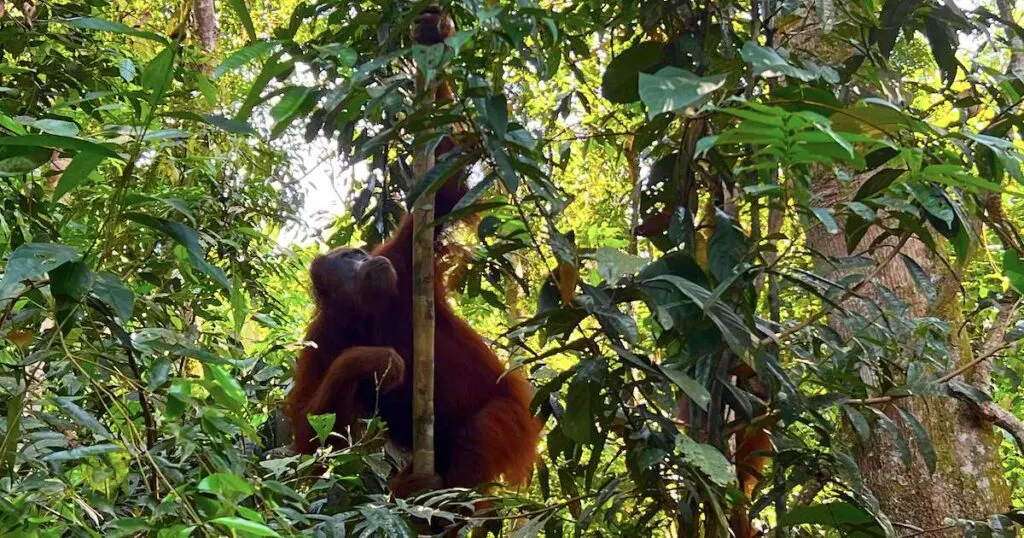
A few islands in Indonesia take the brunt of its tourism: the island of Bali is the front-runner. I’ve met several people who seem to think that Bali is a country on its own.
In more recent years, Indonesian destinations like Lombok, Java, and Komodo have also grown in popularity.
Sumatra is off the beaten backpacking route, and that’s exactly why I adore it. The tourist attractions in Sumatra – if you can even call them that – are not at all saturated.
It’s the first place where I really felt like I could get a real sense for the culture and everyday life in Indonesia.
Then, you have Sumatra’s landscapes: it is home to the largest volcanic crater lake in the world, Lake Toba and multiple volcanoes, including ones that you can hike safely.
There are remote islands with tribes, world-renowned waves, and silky beaches. There are also mountain ranges, lakes, valleys, canyons, and fishing towns.
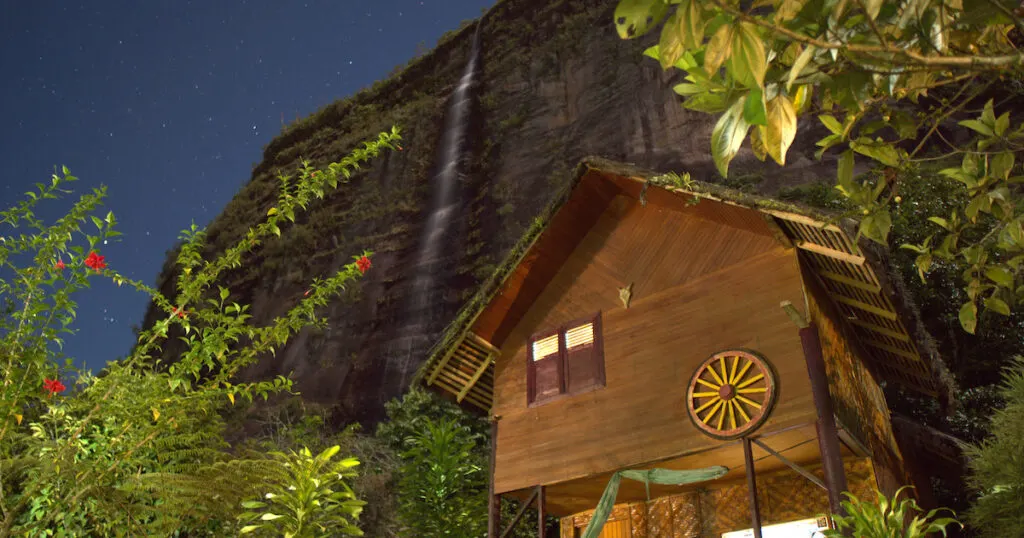
Abdi Homestay in Harau Valley
Seeing orangutans in Sumatra was one of the biggest highlights of my travel in southeast Asia. Nothing can compare to the way the 191-pound creatures teeter between thin vines and trees.
Even if you have already seen the orangutans in Borneo, Sumatra is still worth visiting. The orangutans in Sumatra are slightly lighter in colour and they typically have longer fur and narrower faces than their Malaysian relatives.
Sumatra is not a party backpacking destination. As a predominantly Muslim island, there are no bars or clubs, and I didn’t see a hint of alcohol anywhere.
Hostels are not really a thing in Sumatra yet, either. Most of the people travelling Sumatra are couples, solo travellers, and small friend groups. You’re likely to meet very few people on your travels, and if you do, it’ll mostly happen in the popular homestays in north Sumatra.
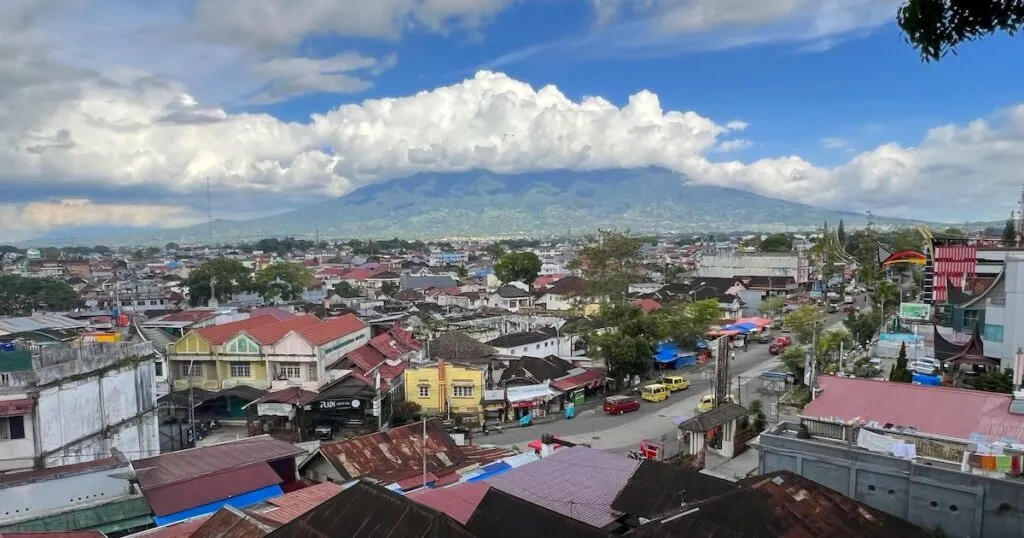
Many people are put off of visiting Sumatra because of its headlines: earthquakes, tsunamis, and flash flooding. Sumatra is, to be frank, prone to natural disasters. It is located along the Ring of Fire, an area of increased seismic activity.
However, as long as you’re informed about what to do during a tsunami or earthquake, I don’t think you should be put off visiting Sumatra. Earthquakes and tsunamis can happen in many popular destinations in southeast Asia and in the world – Thailand, too – so why should you skip this particular spot?
Backpacking Sumatra: What are the best months to visit Sumatra?
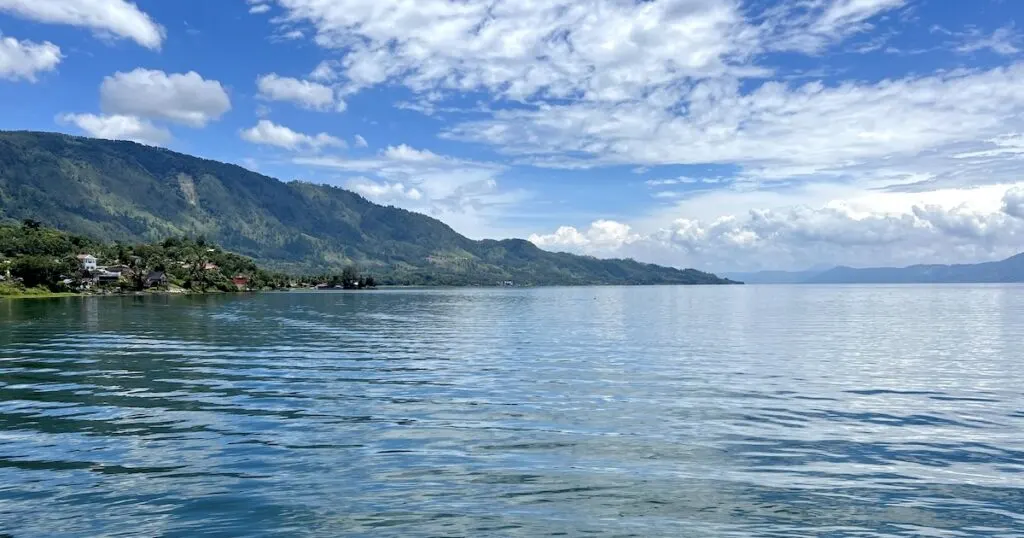
The best months to visit Sumatra are April and May.
These months fall within Sumatra’s dry season, when the weather is hot, humid, and approximately 32 °C (90 °F) most days.
They also fall outside of Sumatra’s burning season, which is between June and October.
Ramadan in Sumatra
You might want to avoid visiting Sumatra in early April because most of the population will be celebrating Ramadan and food is difficult to come by during daylight hours.
Once per year, Ramadan takes place in Sumatra. During this holy period, the island’s Muslim population take part in a month of fasting. As a result, restaurants in Sumatra are closed during daylight hours.
While most homestays will provide you with basic Indonesian meals, I found it very difficult to find substantial food during the day. I found I quickly felt depleted in energy.
Finding food was easier at Lake Toba, which is predominantly Christian.
In 2024, Ramadan takes place between the 10th March and the 9th April.
Burning season in Sumatra
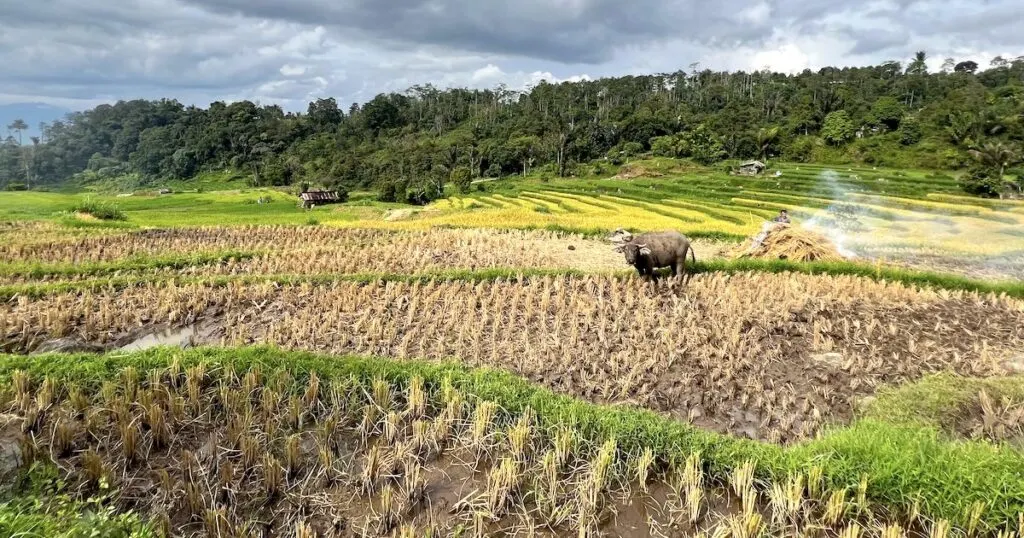
If you haven’t heard of burning season, it is a period of time when farmers in southeast Asia use slash and burn methods to dispose of old crops.
When the crops are burnt, a haze forms and spreads across southeast Asia (believe me, I experienced the intense haze in Kuala Lumpur in Malaysia).
Burning season in Sumatra is between June and October. It is worst between July and September. The air quality in Sumatra decreases. Many country’s residents are told to stay inside to avoid respiratory symptoms.
The views in Sumatra also become hazy, making the scenery less impressive. You should try to avoid travelling during burning season.
Weather in Sumatra
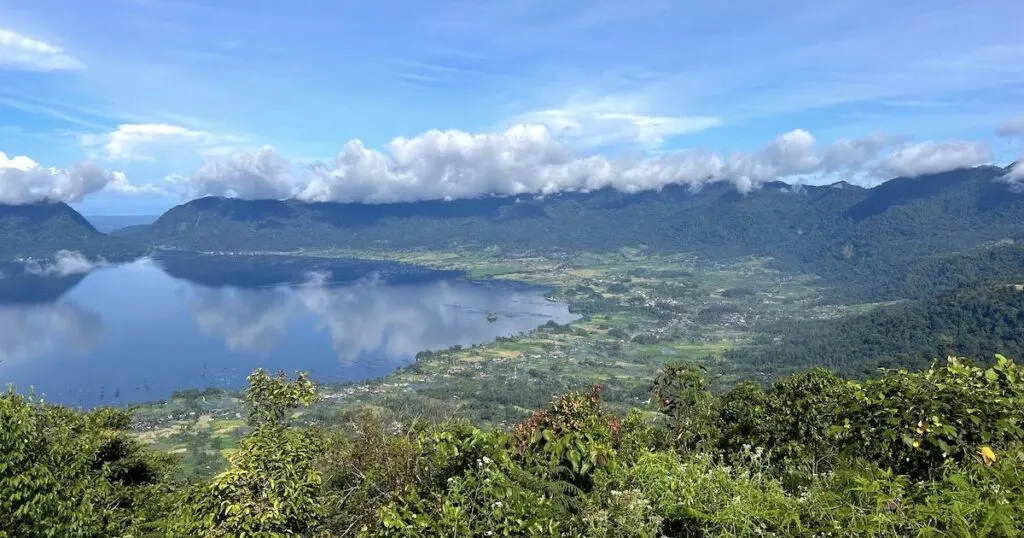
There are two main seasons in Sumatra:
Dry season (between February and August):
Average temperature: 32 °C
Daylight hours: 12 hours
The tropical climate means that rainstorms still occur, but they aren’t likely to interrupt your travel plans.
The weather is likely to be consistently hot, humid, and sunny with small episodes of rain.
Wet season (between September and January):
Average temperature: 30 °C
Daylight hours: 12 hours
Monsoon season begins in September (in north Sumatra) or October (in west and south Sumatra), which can cause flooding and disruption to public transport.
Mosquito-borne illnesses like malaria and leeches are more common during wet season. Outdoor activities are more dangerous due to the possibility of flooding.
It’s very important to wear mosquito repellent and use other preventive measures like mosquito coils. Anti-malaria tablets might be advisable.
Altitude differences
In the highlands of Sumatra, temperatures are more moderate. They’re likely to range between 20 and 28 °C depending upon the weather and the altitude.
Backpacking Sumatra: How many days do you need in Sumatra?
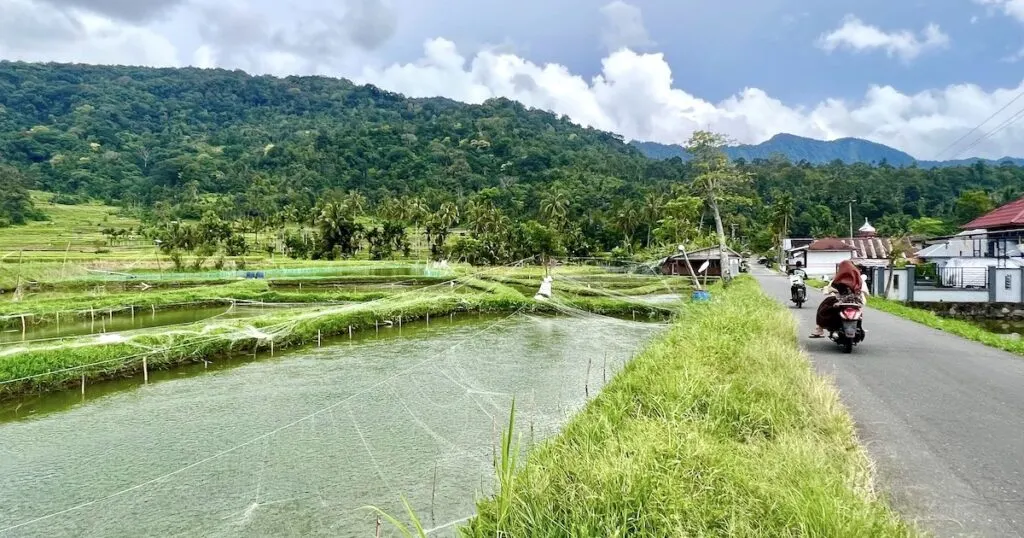
Sumatra is a big island. At its widest point, the island measures 435 kilometres. From north to south, the island is 1,790 kilometres long.
You need time to travel the entirety of Sumatra.
To travel north and west Sumatra, you should allow at least two weeks to one month.
Travelling between north and west Sumatra requires overnight bus transport.
You can travel just north or west Sumatra – not both – in as little as 10 days.
Ideally, to travel Sumatra in its entirety, including the north, west and south Sumatra, you need at least three weeks to one month.
Visas in Sumatra
To travel Sumatra as a foreigner, you will need an Indonesian tourist visa.
For most international passports, Visas on Arrival are valid for 30 days only.
How to extend your visa on arrival in Sumatra
Most Visas on Arrivals can be extended once for an additional 30 days. The only way to do this is by applying in person at an immigration office.
The process will require visiting the office in person more than once, with the first visit being at least 14 days before your visa expires.
You need to find a suitable ‘Kantor Imigrasi’.
Visa extensions can be arranged in Medan in North Sumatra and in Padang in West Sumatra, according to Google Reviews.
There are a few other immigration offices in Sumatra, but I can’t say with 100% certainty that they offer this service. Please check by contacting the offices in advance.
Backpacking Sumatra: How to get to Sumatra
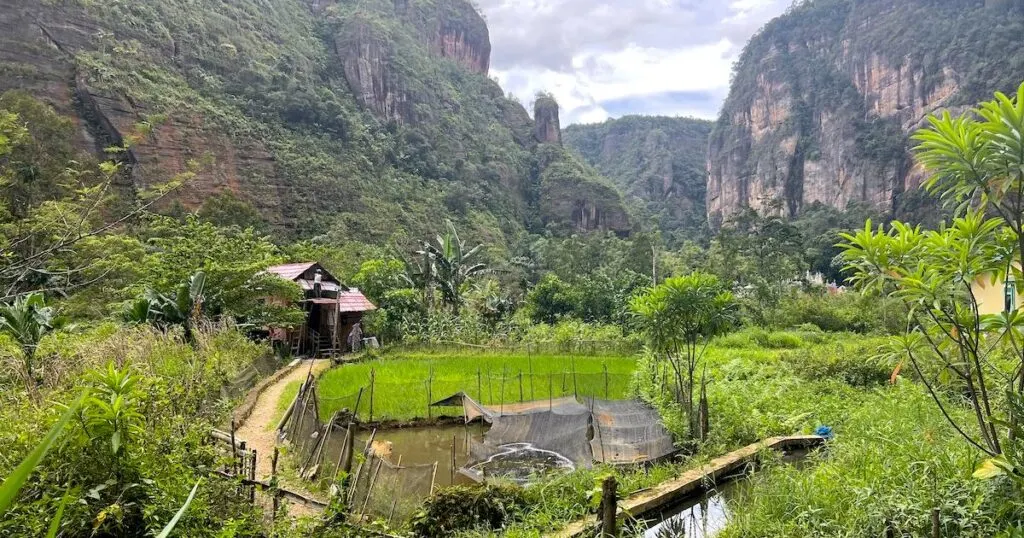
The best way to get to Sumatra will depend upon where you’re departing from.
If you’re departing from a country far away from Sumatra, the best and cheapest option is to fly into Medan, the largest city in Sumatra. The city is in the north of Sumatra and a good base to start your itinerary.
AirAsia will provide the cheapest connecting flights from Kuala Lumpur, Singapore and Bangkok.
If you’re travelling the Indonesian island of Java (especially in the north of Java, near to Jakarta), you can take the ferry from the port of Merak at the very northern tip of Java. They bring passengers to south Sumatra.
From there, you can explore south Sumatra (the most offbeat part of the island) or immediately take a night bus to west Sumatra.
If you’re visiting mainland Malaysia before backpacking Sumatra, you can also take the ferry from Port Dickson or Malacca to Damai in east Sumatra. It may be slightly cheaper than a flight from Kuala Lumpur to Medan.
The best route to take is the ferry from Malacca, as it is a UNESCO World Heritage Site with a variety of historical attractions and only a couple of hours by bus from Kuala Lumpur.
You must book the ferry in person at the port, and take enough cash in MYR or IDR to buy your visa upon arrival in Sumatra. The Malaysia-Sumatra ferry is run by the Indomal Fast Ferry company.
You may need to purchase a return ticket or show proof of your onward journey out of Indonesia, although I wasn’t asked for this. From Damai, you will need to haggle a taxi to take you to the bus station to book an overnight bus to west Sumatra or north Sumatra.
Don’t pay more than 60,000 IDR or you’re being ripped off. Ask them to stop at an ATM and a tourist SIM card shop en route.
Backpacking Sumatra: How to get around Sumatra
Bus is the primary form of transport around Sumatra. These can be divided into local buses and long-distance buses. There are also local taxi and Grab services.
Local travel in Sumatra
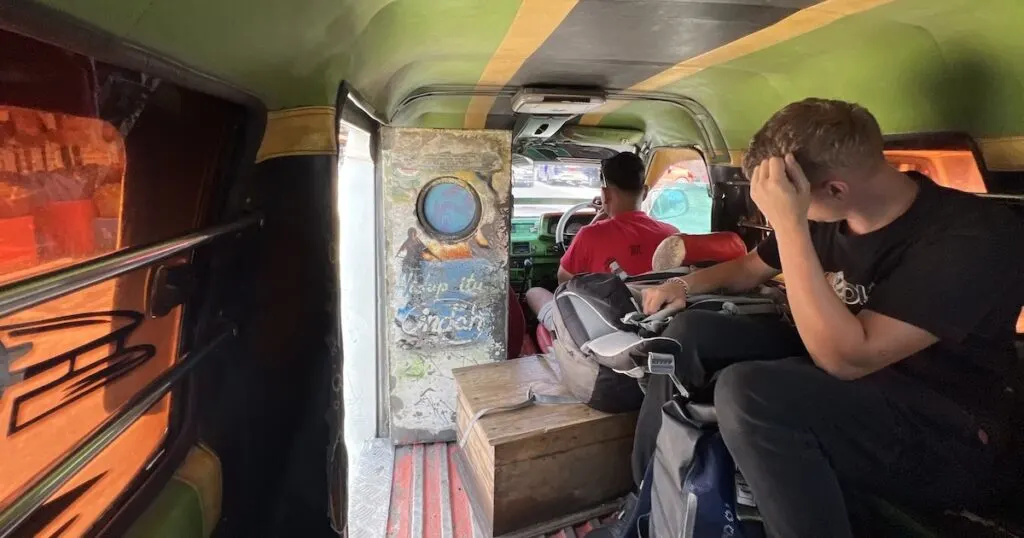
There are three main options for travelling locally in Sumatra (e.g. from one destination to another in the same town or city):
- E-Hailing services such as Grab or GoJek: The easiest and best way to travel is using Grab or GoJek, which act in the same way as Uber. Using an internet connection, you order an affordable taxi (in the scooter or car form) using your smartphone. You agree on the fare before ordering the taxi, leaving no surprises.
- Taxis: Taxis are another option, but they are more expensive than a Grab or GoJek. You will need to haggle the price.
- Buses: In some destinations, such as Medan, there are also buses available. To be honest, unless you want to set yourself a challenge of travelling by public transport, you’re better off sticking to Grab or another e-hailing service for the convenience. The taxis are inexpensive.
Long-distance travel in Sumatra
There are three main forms of long-distance travel in Sumatra:
1. Local buses
Local public buses are used by everyone in Sumatra to get from A and B, not just for tourists who are backpacking Sumatra.
This might be a large overnight bus with air-con or a small, rickety mini-bus where the windows hardly open.
Local buses, in general, are cheap and fairly easy to navigate.
Every time I wanted to take a public bus for a journey under five or six hours, I turned up at the bus station on the same day and waited less than half an hour. I paid in cash on the bus.
For overnight journeys, you need to turn up to the bus station at least one day before to book your ticket in advance because they quickly get full up.
The ‘executive’ buses are popular because they feature luxuries likeair conditioning, reclining seats, extra leg-room, blankets, and toilets.
In general, I found local buses to be the cheapest way to travel. For short journeys, I didn’t mind the lack of comfort because I have small legs. However, tall people will struggle with the lack of legroom in small minivans and mini buses for extended periods of time.
Tourist buses
A tourist bus is a car or a minivan shared between a group of tourists who do or do not know each other.
The bus operator usually takes separate bookings at a fixed price and groups ourists travelling in the same direction together.
If you’ve travelled in Mexico or Cuba, you’ll realise that they are similar to the collectivo taxi concept.
Tourist buses currently only run in north Sumatra because there are not enough tourists in west Sumatra. Having started my travels in west Sumatra on local buses, I was frustrated because tourist buses are more expensive but just as cramped as local buses, sometimes with the same delays (or more) because they are taking more indirect routes to drop tourists at their different homestays.
Flying in Sumatra
There are airports in Medan (north Sumatra), Padang (west Sumatra), and Palembang (south Sumatra), Gunungsitoli (Nias Island), and various other locations in Sumatra.
However, the flights are infrequent and expensive. You can expect to pay £50 – £100 for a flight between Medan and Padang.
Meanwhile, a comfortable ‘executive’ overnight bus with air conditioning costs under £15 for the same journey.
Flying is only helpful if you want to skip any overnight bus journeys between north or west Sumatra. Also, consider whether travel delays will make you miss your flight.
Also, is it worth going back to Medan for a flight to Padang if you’re already partway down the island e.g. already at Lake Toba?
Travel insurance is essential for any trip abroad. If you’re in an accident or experience an emergency, you need adequate cover. I recommend Staysure for single or multiple trips per year and SafetyWing for digital nomads.
The Best Route for Backpacking Sumatra
I’m going to begin by listing the best destinations in north and west Sumatra and why you should consider visiting them.
Then, I’m going to provide the best routes for the amount of time you’re visiting Sumatra – one month, three weeks, two weeks, 10 days, or one week.
Backpacking North Sumatra Itinerary
1. Medan
Best for: Historic sites and culture
Time needed: 1-2 days
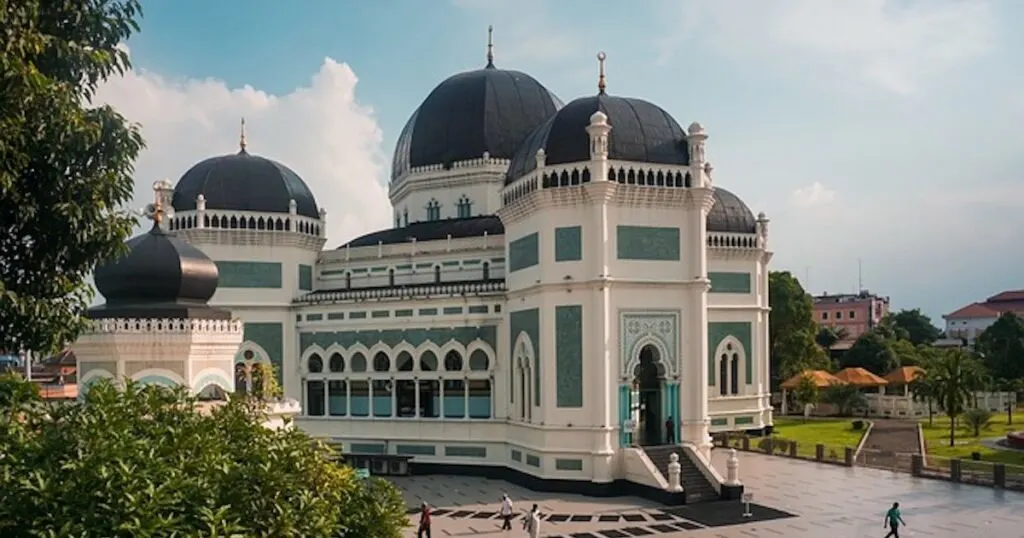
Medan is the biggest city in Sumatra population-wise. A brief visit is all you need when you’re backpacking Sumatra, unless you consider yourself a history and culture buff.
Some of the most interesting attractions in Medan are the Great Mosque of Medan, which has Islamic and European influences, and Maimun Palace, the royal house of the Sultanate of Deli.
For dinner, hunt down Indonesian street food on Jalan Selat Panjang, which is famous for its food stalls. There are also several temples you can explore in the city.
If you want to explore Medan with an informative guide, you could try a Medan guided group tour.
Where to Stay:
- Backpackers: Semalam at Sun Yat Sen, a boutique hostel in Chinatown.
- Mid-budget: Ibis Styles Medan
- Luxury: JW Marriott Medan
2. Bukit Lawang
Best for: Orangutan jungle trekking
Time needed: 2 days – 10 days (depending upon the length of your jungle trek)
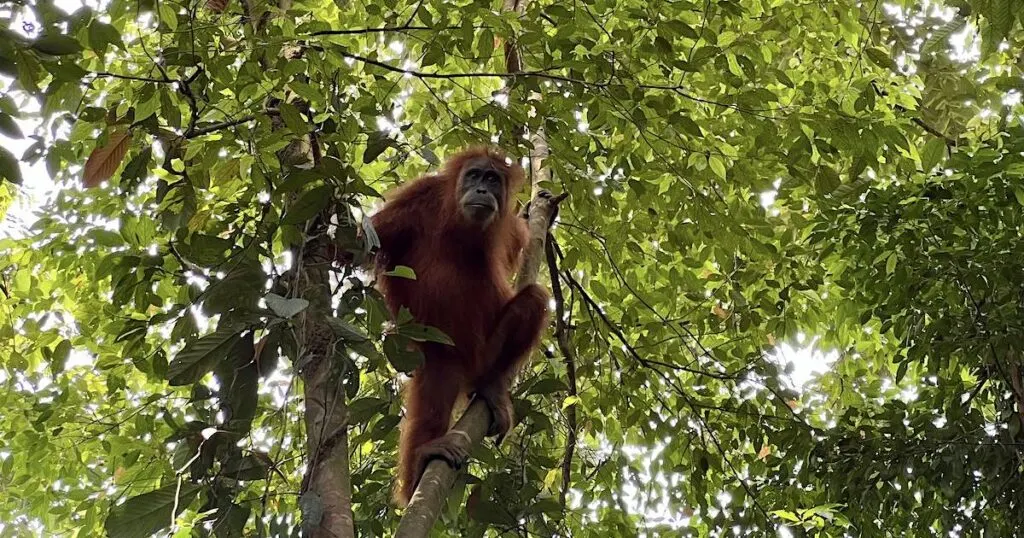
Bukit Lawang is the reason many people visit Sumatra. The small village is home to the largest Sumatran orangutan sanctuary in Sumatra.
The sanctuary is located in the Gunung Leuser National Park, which has been declared a UNESCO World Heritage Site.
Jungle trekking to see orangutans can last anywhere between one day and 10 weeks, with overnight camping increasing your chances at seeing orangutans, along with other wildlife such as Thomas’s langur and gibbons. Most people do a one- or two-day trek.
In Bukit Lawang, you can also go tubing on the river or take part in farm tours, a becak tour, or visit the Bat Cave.
Where to Stay:
- Best Pick (££): Ecolodge Bukit Lawang (note that this accommodation sells out weeks in advance in high season)
- Mid-budget: Jungle Inn Bukit Lawang
- Backpackers: Sam’s Bungalows
Best Orangutan Trekking Tours:
- 1 Day: Four-hour jungle trek with Sumatra EcoTravel.
- 2 Days: 2 Days and 1 Night jungle trek, including overnight camping and river tubing, with Sumatra EcoTravel.
- 3 Days: 3 Days and 2 Nights jungle trek with overnight camping and river tubing. Some proceeds from this tour go towards supporting a local school in Bukit Lawang.
If you’re limited on time or you don’t want to spend time overnight in the village (the village was hit by a severe flash flood back in 2003 due to deforestation), note that you have the option of taking an orangutan trekking day tour from Medan instead.
Visit my guide to the best things to do in Bukit Lawang.
3. Berastagi
Best for: Volcano trekking
Time needed: 2 days
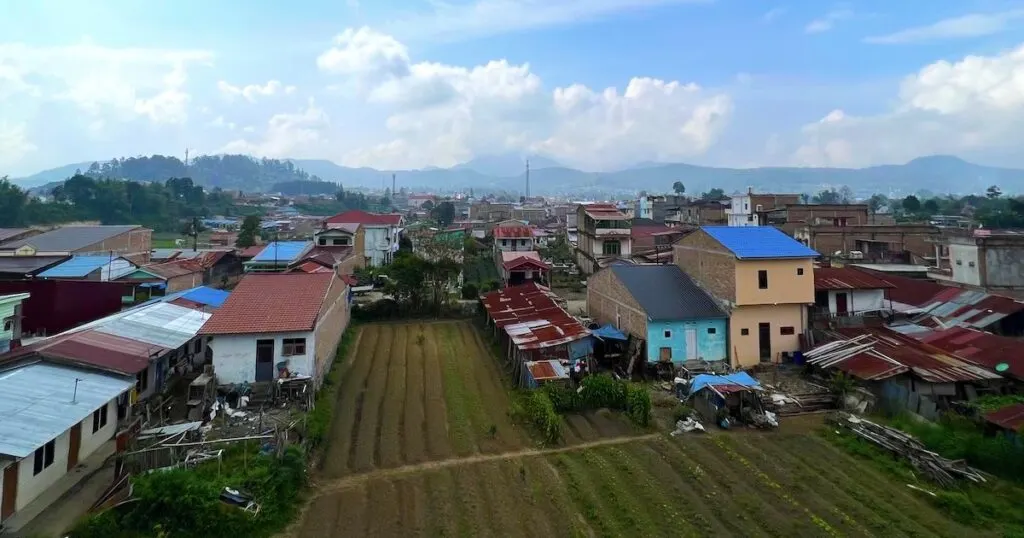
Berastagi is a town in the Karo highlands between Medan and Lake Toba.
It is best-known as a base for climbing Mount Sibayak, an 2094-metre-high active stratovolcano with hot springs, sulphur fumes, and a cone-shaped crater.
Unlike the town’s other volcano, Mount Sinabung, the last eruption of Sibayak was in 1881 and it has been deemed safe to climb.
The town’s name literally means ‘city of rice’. It has a thriving farm industry, so visiting the market is another must.
You can also visit the remains of local villages demolished by Mount Sinabung’s eruptions or take a day trip to Sipiso Piso, an impressive 120-metre plunge waterfall.
Where to Stay:
- Backpackers: Nachelle Homestay provides a map with local information and arranges volcano trekking tours.
- Luxury: Sinabung Hills Berastagi
4. Lake Toba (Samosir Island)
Best for: Swimming, relaxation, Batak culture, and hiking
Time needed: 3-5 days
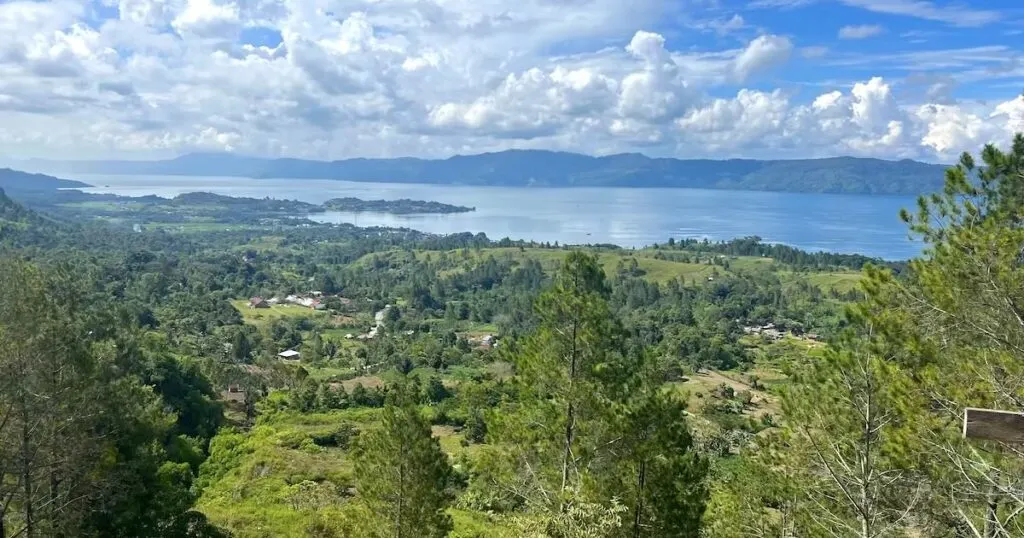
After Bukit Lawang, Lake Toba is the second best-known spot in Sumatra. It is the largest crater lake in the world. Swimming in the lake is a bucket-list activity for many.
Samosir Island, a small island with an ancient Batak culture, is the most popular place to stay.
You can scooter around the entire island in one or two days, and visit sites to learn about the tribal culture. The island is the original home of the Bataks.
Where to Stay:
- Backpackers: Reggae Guesthouse or Laster Jony’s
- Mid-budget: Zoe’s Paradise Waterfront Hotel
- Glamping: Bobocabin Signature Toba
Visit my Samosir Island and Lake Toba travel itinerary or check out the best hotels in Lake Toba.
5. Aceh
Best for: Accessing surfing beaches and diving sites
Time needed: 2-3 days
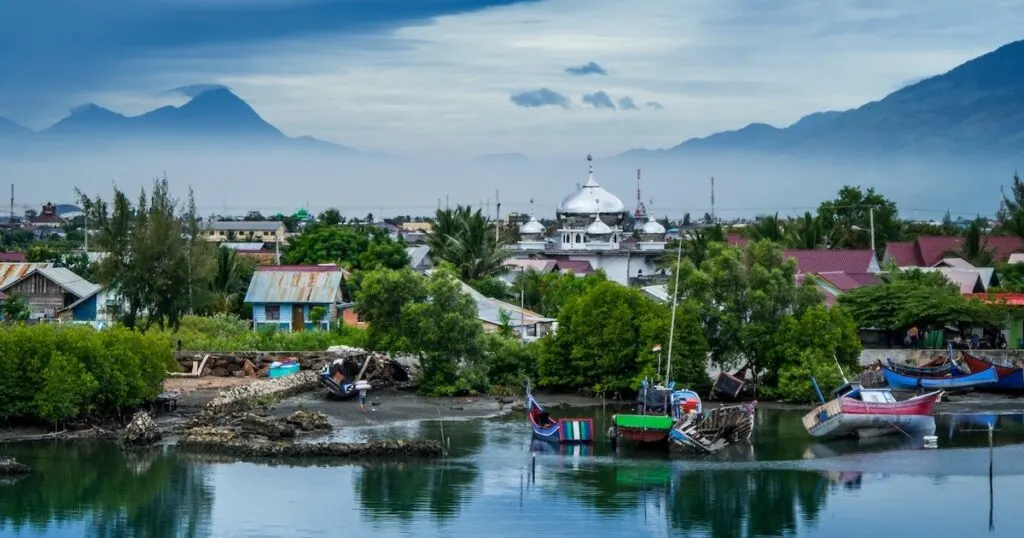
Aceh is a city at the very northern tip of Sumatra. Sadly, it’s best-known for being devastatingly hit by the 2004 Indian ocean tsunami (the same tsunami that badly hit Phuket in Thailand).
However, the city also has good access to beautiful beaches and diving sites, as well as nearby mountains with hikes.
Surfers especially like Lhoknga Beach, 15 kilometres away from the city. There’s a tsunami museum in the city if you’d like to learn more about the 2004 disaster and how the city was rebuilt.
From Aceh, you can take a boat to Pulau Weh, a popular island.
Where to Stay: Lala Hostel
6. Pulau Weh (Sabang)
Best for: Diving, snorkelling, and relaxing
Time needed: 3-5 days
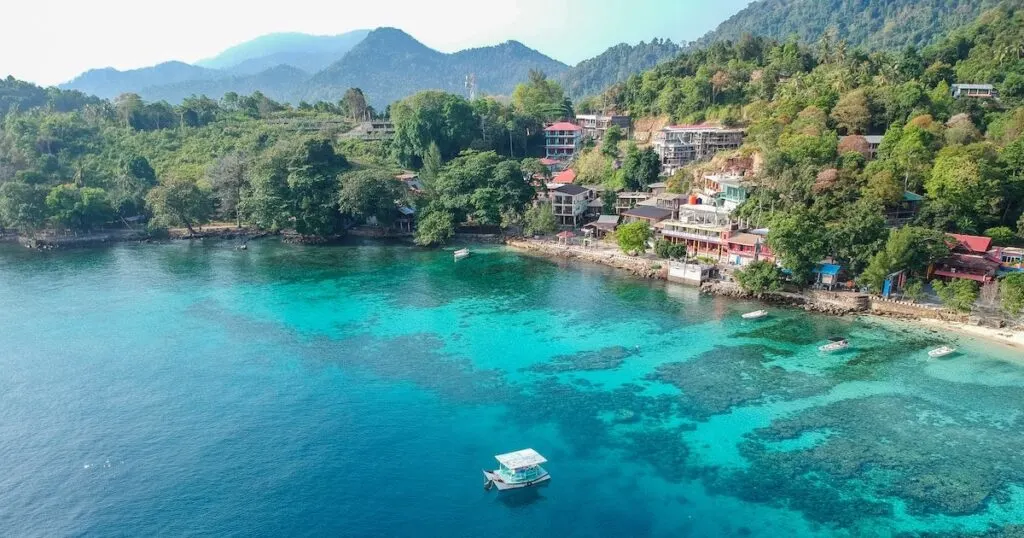
Pulau Weh, or Sabang as it’s also known, is a small island accessible by a 45-minute fast boat from Aceh.
Diving and snorkelling are the main draws on the island, as although some of the shallow reefs were damaged by the 2004 tsunami, the deeper reefs are of incredible quality.
The island is mostly covered in palm trees and has hot springs, beautiful ‘hidden’ coves, Japanese bunkers, and a volcano.
The Best North Sumatra Itinerary
Those are the main destinations you’ll want to be aware of in north Sumatra, but in what order should you visit them?
The following itineraries are the best routes for backpacking north Sumatra.
Aceh and Pulau Weh are the most time-consuming to visit, so you may want to leave these destinations out of your backpacking Sumatra itinerary if you’re short on time.
- Medan – Aceh – Pulau Weh – Aceh – Medan – Bukit Lawang – Berastagi – Lake Toba
- Medan – Bukit Lawang – Berastagi – Lake Toba (if you don’t have time to visit Aceh or Pulau Weh).
Backpacking West Sumatra Itinerary
1. Bukittinggi
Best for: Canyon trekking and visiting underground Japanese tunnels
Time needed: 2 days
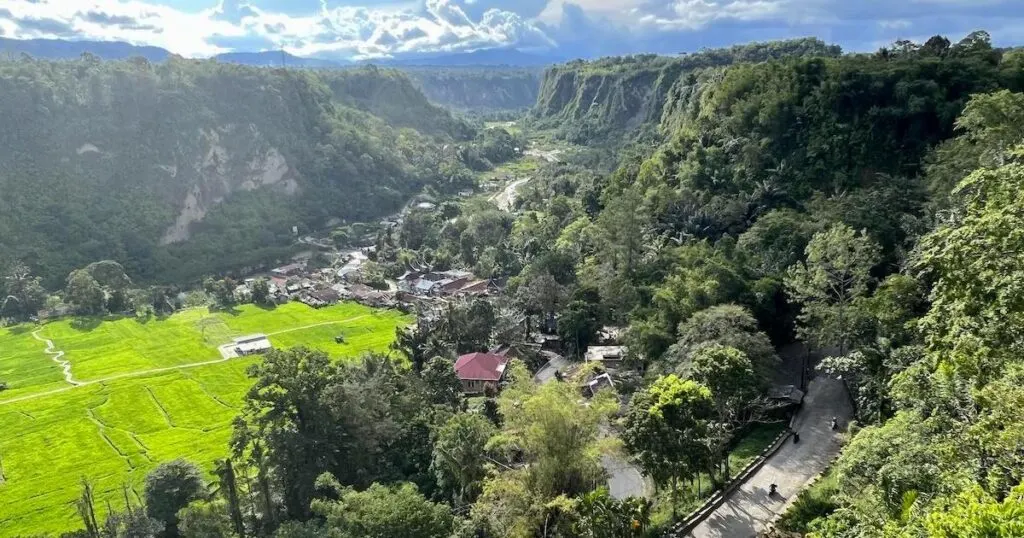
Bukittinggi’s best feature is most definitely Sianok Canyon, a wide canyon bordered by rocky cliffs and featuring the Koto Gadang Great Wall which has been likened to a miniature version of the Wall of China.
The town has views of Mount Merapi and Mount Singgalang, two volcanoes where unfortunately trekking is currently off-limits.
However, with underground Japanese tunnels from World War II and nearby forests with the famous smelly flower titan arum, Bukittinggi is well worth visiting.
Where to Stay:
- Best pick (£££): Padi Ecolodge, traditionally-designed wooden lodges at the entrance to the canyon.
- Budget: Aur Kuning Hostel
- Luxury: The Balcone Hotel & Resort or Novotel Bukittinggi
Visit my guide to the best things to do in Bukittinggi Sumatra.
2. Harau Valley and Payakumbuh
Best for: Hiking trails, rock climbing, and peaceful rice terraces and farms
Time needed: 2-4 days
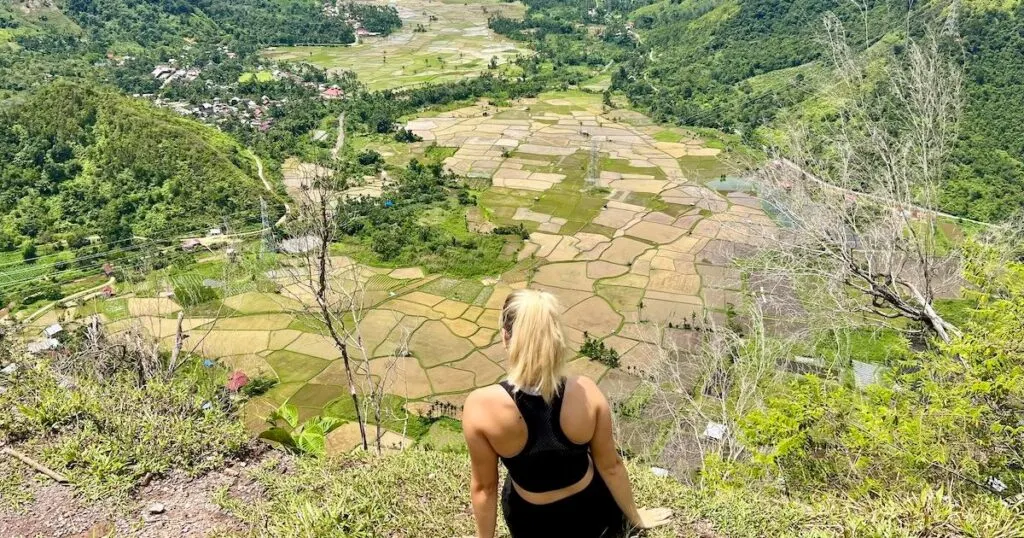
Aptly named the ‘Yosemite of Indonesia’ by the tourism board and also with a keen likeness to Switzerland, Harau Valley is exactly the place you should go if you like scenery with waterfalls, tall cliffs, rice terraces, and farms.
There are hiking trails with views over the rice fields, as well as climbing routes for professional rock climbers.
Take an opelet (the motorised version of a becak) into Payakumbuh, the local town, to explore the markets and local restaurants and to see its traditional Minangkabau architecture.
Where to Stay:
Staying at Abdi Homestay is practically a backpackers’ rite of passage. The Swiss-style chalets are based underneath one of Harau’s most impressive waterfalls and overlook rice fields. You can book directly through the WhatsApp number on the Abdi Homestay Instagram.
Visit my Harau Valley travel guide for the best things to do.
3. Lake Maninjau
Best for: An offbeat crater lake surrounded by rice terraces and farms
Time needed: 2 days
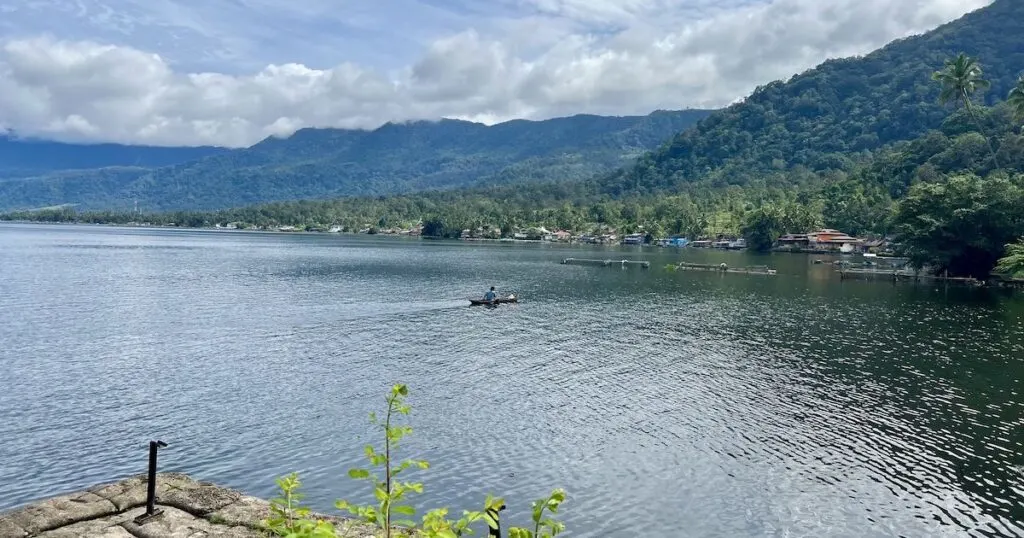
Lake Maninjau is a crater lake based in a hilly bowl of rice terraces, accessible by a road with 44 hairpin turns.
It is tiny compared to Lake Toba in the north of Sumatra, but this is exactly what makes it feel so much more intimate.
It’s possible to cycle (or scooter) around the entire 50-kilometre road around the lake in one day, passing by local fishing villages, rice terraces, fish farms, floating mosques, schools, parks, and tiny local shops and restaurants.
The Puncak Lawang viewpoint is an unmissable spot above the lake. You can’t swim in the lake due to the fish farms, but I count it as my second-favourite destination in Sumatra.
Where to Stay: Beach Guesthouse or Eka’s Bungalows (previously called Muaro Beach Bungalows)
Visit my guide to the best things to do at Maninjau Lake.
4. Sikabu
Best for: Rice terrace scenery and glamping
Time needed: 1-2 days
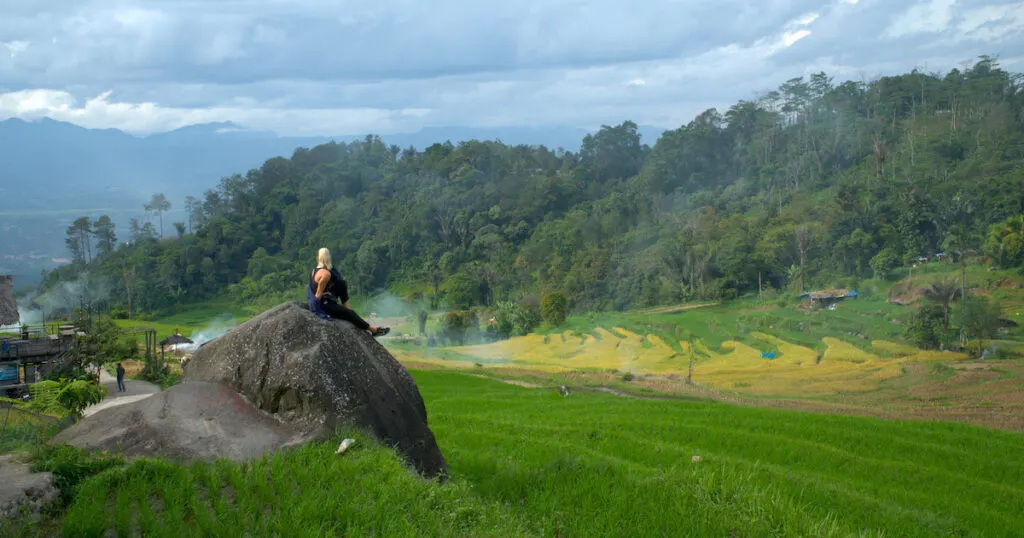
Sikabu is the ultimate undiscovered destination in Sumatra. Right now, it is mainly popular with regional Indonesian tourists and yet to make a mark on the international Sumatra tourist map.
If I hadn’t taken a day trip there from Harau Valley, I’d have had no idea it existed.
The tiers of rice terraces, occupied by grazing water buffalos and farmers, have views over Payakumbuh and Mount Sago.
There are waterfalls and a biking park nearby, but the main attraction is the quiet rice terrace environment, coffee shops and restaurants, and the ridiculously beautiful Sikabu Glamping.
5. Padang
Best for: Food, culture, beaches, and the ferry to the Mentawai Islands
Time needed: 1-2 days
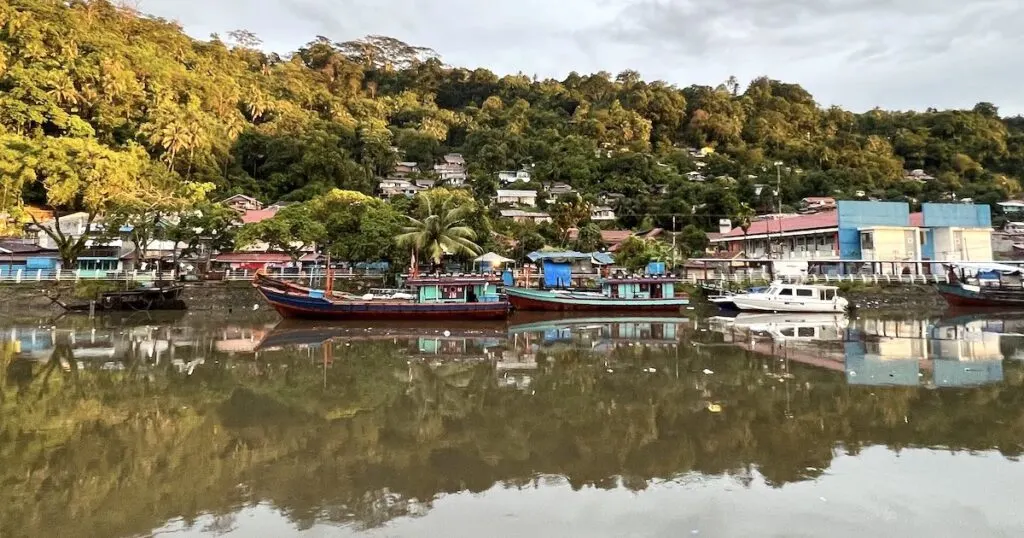
Padang is the departure point for the Mentawai Islands, but it’s also a good place for foodies. Padang cuisine is famous, especially nasi Padang (Padang rice), which is a style of dining where restaurants stack up to 50 different plates and diners pick and choose their dishes.
Padang has a Chinatown, a colonial Dutch old quarter, a museum, and a famous sunset beach called Pantai Air Manis.
Fast ferries to the Mentawai Islands run several times per week, usually on Tuesday, Thursday and Saturday, and take up to six or seven hours.
Where to Stay: Kokos Hostel (hostel with dorms) and The View Padang.
6. Mentawai Islands (including Siberut Island)
Best for: Surfing, tribal culture and relaxation
Time needed: 3 – 7 days
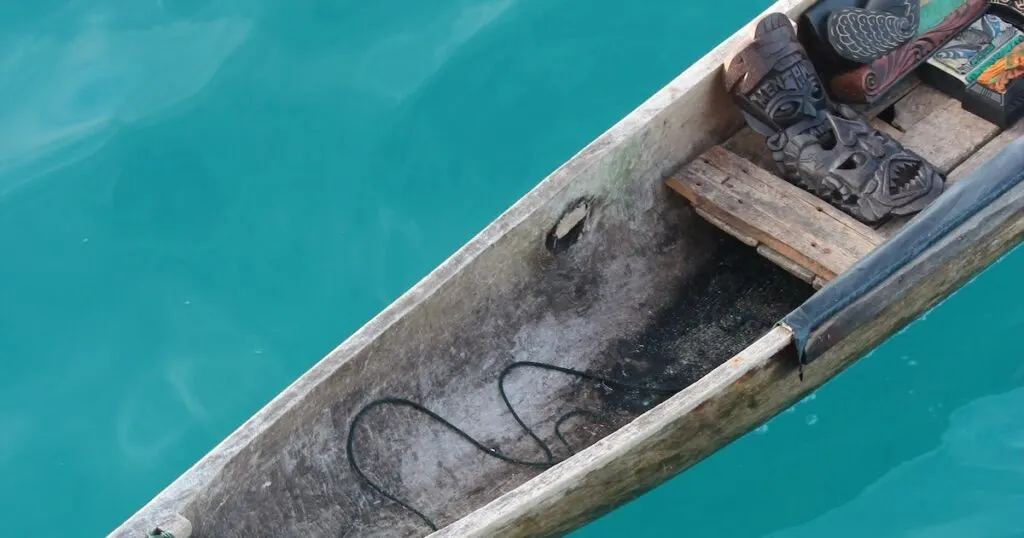
The Mentawai Islands seem like a separate place to Sumatra. The islands are considered to be one of the best surfing destinations in Indonesia. Surf camps are very popular.
If you’re not a surfer, don’t worry, because the island has silky-soft beaches and great snorkelling spots too.
Semi-nomadic tribes inhabit the islands, and responsible tourism agencies can arrange visits to the tribes to learn about their culture.
Where to Stay: The most popular surf camp (which is all-inclusive) is Nyang Ebay Surf Camp. The Kingfisher Mentawai Resort is also popular, but more upscale.
7. Nias Island
Best for: A remote island with surfing beaches and caves
Time needed: 3-4 days
Nias Island is another barely-explored island off the west coast of Sumatra. The island is made up of palm, cocoa and rubber trees. It has small villages, waterfalls, and caves, as well as pristine beaches and corals for snorkelling.
Surfing is also popular at Nias Island. One small museum divulges the local island culture, which is distinct from the mainland; many of the elders don’t speak any Indonesian, because the island has its own language.
Where to Stay:
- Budget: Oseda Nias Surf House and Nias Surf Stay
The Best West Sumatra Itinerary
The best west Sumatra itinerary will ideally visit all of the following destinations, but if you’re short on time, your best bet is to miss out on visiting Nias Island or the Mentawai Islands.
The Mentawai Islands, however, are a must-visit for many, and require at least 3-5 days.
If visiting Mentawai is a non-negotiable for you, you may have to skip destinations like Sikabu or Lake Maninjau.
- Bukittinggi – Harau Valley/Payakumbuh – Sikabu – Lake Maninjau – Padang – Mentawai Islands – Nias Island (full itinerary arriving by bus from north Sumatra).
- Padang – Mentawai Islands – Bukittinggi – Harau Valley/Payakumbuh – Sikabu – Lake Maninjau – Nias Island (full itinerary arriving by a flight in Padang).
- Bukittinggi – Harau Valley/Payakumbuh – Sikabu – Lake Maninjau (without the islands).
Sumatra Itinerary: 3 Weeks
Three weeks backpacking Sumatra gives you plenty of time to visit both north and west Sumatra.
You may have to skip Aceh in the very north of Sumatra and/or some of the islands in the west.
- Medan: 1 day
- Bukit Lawang: 3 days (includes two days of orangutan trekking and one half-day of travel)
- Berastagi: 2 days (includes one day of volcano trekking and one half-day of travel)
- Lake Toba: 3 days (including one travel day). Take an overnight bus to Bukittinggi in West Sumatra.
- Bukittinggi: 2 days (including one short journey
- Harau Valley/Payakumbuh: 2 days
- Sikabu: 1 day
- Travel day: 1 day. Take a taxi to Payakumbuh, a bus to Bukittinggi, and a second bus to Lake Maninjau.
- Lake Maninjau: 2 days
- Padang: 1 day
- Mentawai Islands: 4 days
- Travel day: Take a flight to Medan to return home (book in advance) or take an overnight bus to west or south Sumatra for the ferry terminals onwards to Malaysia or Java.
Sumatra Itinerary: 2 Weeks
The following two-week Sumatra itinerary covers north and south Sumatra.
- Medan: 1 day
- Bukit Lawang: 3 days
- Berastagi: 1 day
- Lake Toba: 2 days. Take an overnight bus to Bukittinggi in West Sumatra.
- Bukittinggi: 2 days
- Harau Valley/Payakumbuh: 2 days (including a possible afternoon visit to Sikabu)
- Lake Maninjau: 2 days
- Padang: 1 day (mostly a travel day)
- Travel day: Take a flight to Medan to return home (book in advance, or take an overnight bus to west or south Sumatra for the ferry terminals onwards to Malaysia or Java.
The following two-week itinerary focuses entirely on north Sumatra:
- Medan: 1 day. Take an overnight bus to Aceh.
- Aceh: 1 day
- Pulau Weh (Sabang): 2 days
- Aceh: 1 day. Take an overnight bus to Medan.
- Bukit Lawang: 3 days
- Berastagi: 2 days
- Lake Toba: 3 days. Take an overnight bus to Bukittinggi in West Sumatra.
- Travel day: 1 day. Take a bus from Lake Toba to Medan.
The following two-week itinerary focuses entirely on west Sumatra and the Mentawai Islands:
- Travel day: 1 day. Take an overnight bus to Bukittinggi from Medan or another city.
- Bukittinggi: 2 days
- Harau Valley/Payakumbuh: 2 days
- Sikabu: 1 day
- Lake Maninjau: 2 days
- Padang: 1 day (including a half-day of travel)
- Mentawai Islands: 4 days
- Travel day: Take a flight to Medan to return home (book in advance), or take an overnight bus to west or south Sumatra for the ferry terminals onwards to Malaysia or Java.
Sumatra Itinerary: 10 Days
If you only have 10 days (or less) in Sumatra, it’s going to be difficult to visit west Sumatra unless you take a flight immediately from Medan to Padang.
If you do this, you won’t have any time to visit north Sumatra.
A 10-day itinerary for north Sumatra:
- Medan: 1 day
- Bukit Lawang: 3 days
- Berastagi: 2 days
- Lake Toba: 3 days. Take an overnight bus to Bukittinggi in West Sumatra.
- Travel day: 1 day. Take a bus from Lake Toba to Medan.
A 10-day itinerary for west Sumatra (beginning in Padang):
- Padang: 1 day
- Mentawai Islands: 4 days
- Bukittinggi: 2 days (including a half-day bus)
- Harau Valley/Payakumbuh and a day trip to Sikabu: 2 days
- Travel day: 1 day. Take a flight to Medan to return home (book in advance), or take an overnight bus to west or south Sumatra for the ferry terminals onwards to Malaysia or Java.
Sumatra Itinerary: One Week
If you only have one week to go backpacking in Sumatra, I’d recommend staying close to Medan.
You’ll probably only have time to go orangutan trekking and to visit either Berastagi or Lake Toba.
The following itineraries are possible.
Lake Toba and Bukit Lawang:
- Bukit Lawang: 3 days (including two days of orangutan trekking)
- Lake Toba: 3 days
- Travel day: 1 day. Take a bus from Lake Toba to Medan.
Berastagi and Bukit Lawang:
- Medan: 1 day
- Bukit Lawang: 3 days (including two days of orangutan trekking)
- Berastagi: 2 days
- Travel day: 1 day. Take a bus from Lake Toba to Medan.
What to pack and wear when backpacking Sumatra
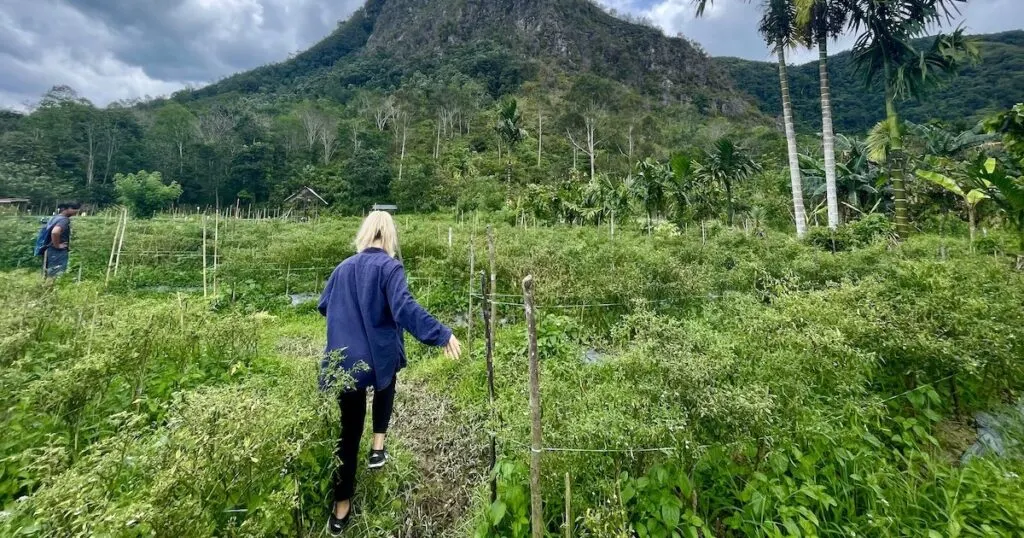
Sumatra is a predominantly Muslim country, so dressing conservatively is essential on the majority of the island. Some places are less conservative, such as Lake Toba, a Christian enclave, and the Mentawai Islands.
There are also mosquitos and the weather to think of, among other things, which is why I’ve created a full guide to what to wear in Sumatra and a full packing list to help you prepare for your trip.
Cost of backpacking Sumatra
Travelling in Sumatra is mostly inexpensive.
Typically, Indonesian main meals cost me between 10,000 IDR and 40,000 IDR, which is equivalent to £0.50 to £2.10 (€0.6 to €2.50).
For basic accommodation in a double room with air conditioning and either a private or shared bathroom, I typically paid between 100k IDR and 220k IDR, which is equivalent to £5.20 to £11.50 (€6 to €13.50).
If you’re sharing the room between two people, you can cut the price of the room in half.
Accommodation is generally slightly more expensive in north Sumatra than in West Sumatra.
Bus travel is the most expensive part of travelling Sumatra. Overnight bus travel between Bukittinggi (west Sumatra) and Medan (north Sumatra) costs 225k IDR for an ‘economy’ bus without air conditioning.
It’s 260k IDR for a bus with a toilet and air conditioning.
Expect to pay 335k IDR for an ‘executive bus’ with extra legroom, air conditioning and a toilet. That’s equivalent to either £11.80, £14, or £17.50.
Short-haul bus journeys via local bus are less expensive and usually cost between 20K and 50K for a one- to six-hour journey.
Tours and activities in Sumatra will be another bigger expense when backpacking Sumatra.
For example, a one-day trekking tour in Bukit Lawang costs around 900-1000k IDR (approximately £50) and a two-day tour costs around 1500k IDR (approximately £80).
Backpacking Sumatra Tips
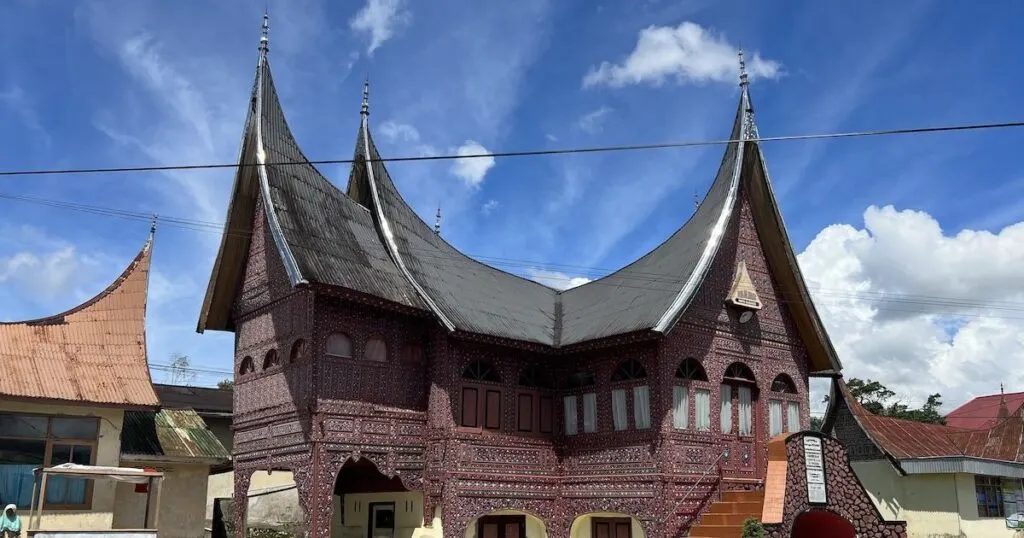
- Read the text carefully when booking your accommodation. If you’re an unmarried couple or friends who are male and female, you won’t be permitted to share a room in some hotels and homestays.
- Bring plenty of mosquito repellent. Mosquito repellent suitable for the skin is hard to find in Sumatra, even in supermarkets. Mosquitos in Sumatra carry malaria, among other diseases. If you do run out, ask for ‘Autan’ mosquito repellant.
- Make time for travel delays due to weather and traffic.
- Monitor news outlets for warnings for natural disasters and stay away from danger zones. They are there for a reason.
- Take a friend. While you can solo travel in Sumatra, it’s harder to meet other travellers because they are less tourists. Most of the people travelling Sumatra are couples or existing groups. In North Sumatra, you’re more likely to meet solo travellers.
- Dress conservatively in Muslim areas (most of the island)
WiFi and Internet in Sumatra
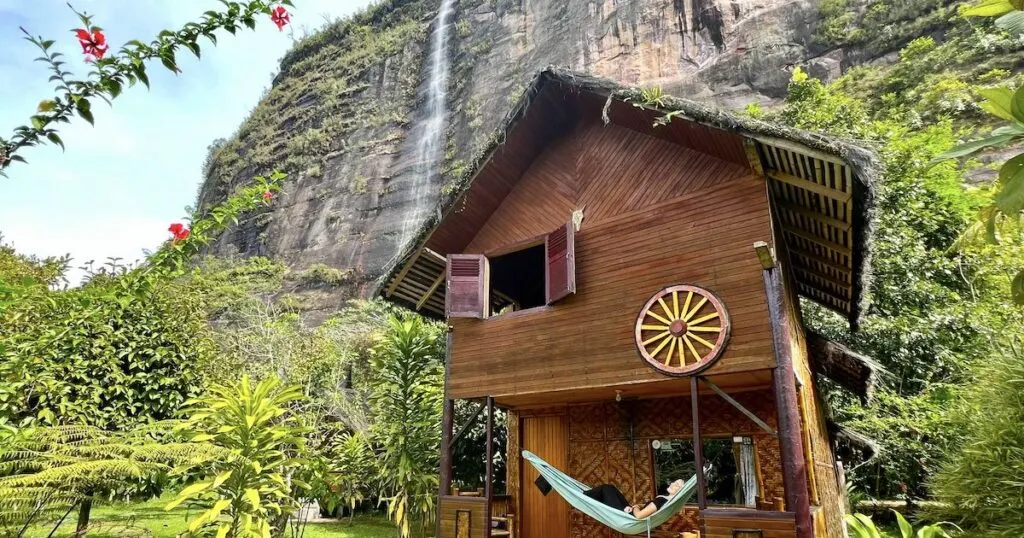
Wi-Fi in mainland Sumatra is mostly stable and fast. To access 4G, you cannot rely on a local SIM card.
Unlike in other parts of Indonesia, foreigners can not use a local SIM card because they are only compatible with phones purchased in Sumatra. Believe me, I tried.
You must buy a tourist SIM card. These are sold in very few places: the only places I can vouch for are Medan airport and one small shop in Dumai (near the ferry port).
I believe they are mostly sold around the entrance points into Sumatra, so buy one as soon as possible upon your arrival.
You can buy an E-Sim for Indonesia too. I did this after missing my chance in Dumai. However, the E-Sim had patchy signal. Some days, it worked. Others, it didn’t for no apparent reason.
My friend and I brought the same E-Sim. When we were in the same location, sometimes one of us would have 4G and the other wouldn’t. For that reason, I’ve linked a different E-Sim.
Places to Visit After Sumatra
1. Malacca, Malaysia
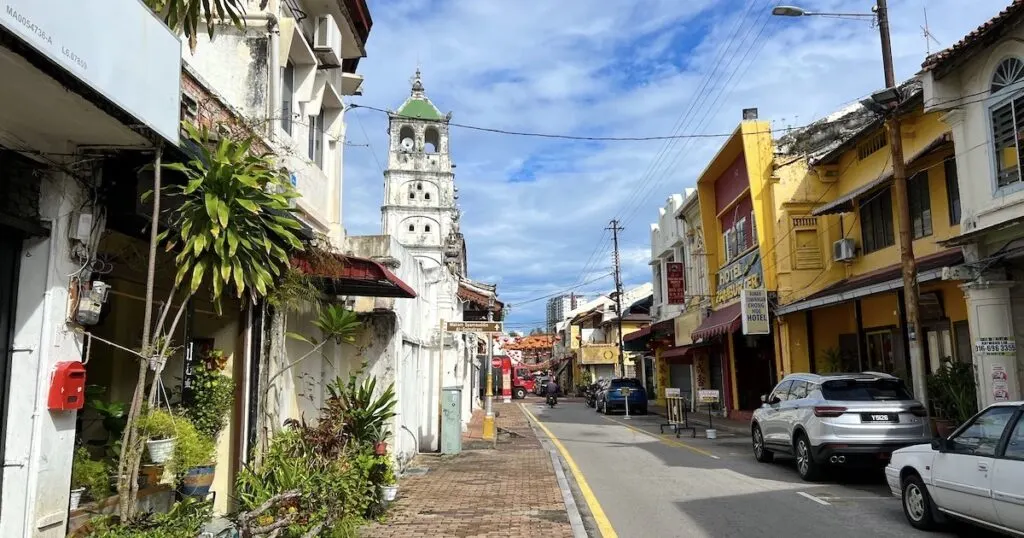
Who could turn down a chance to visit a UNESCO World Heritage Site? Malacca (also Melaka) in Malaysia is accessible by a direct ferry from Sumatra via the port in Dumai. Chinatown is its most famous part, especially the weekend Jonker Street night market.
However, it’s packed to the brim with historical sites, including a 17th-century Chinese temple, an 18th-century Javanese-style mosque, and a church.
River cruises run along the riverfront, which is lined with bars and coffee shops, as well as fascinating street art.
From Malacca, you can visit Kuala Lumpur and continue your travels through Malaysia – to places like Tioman Island, Penang, Ipoh, or the Cameron Highlands, for instance.
2. Java, Indonesia
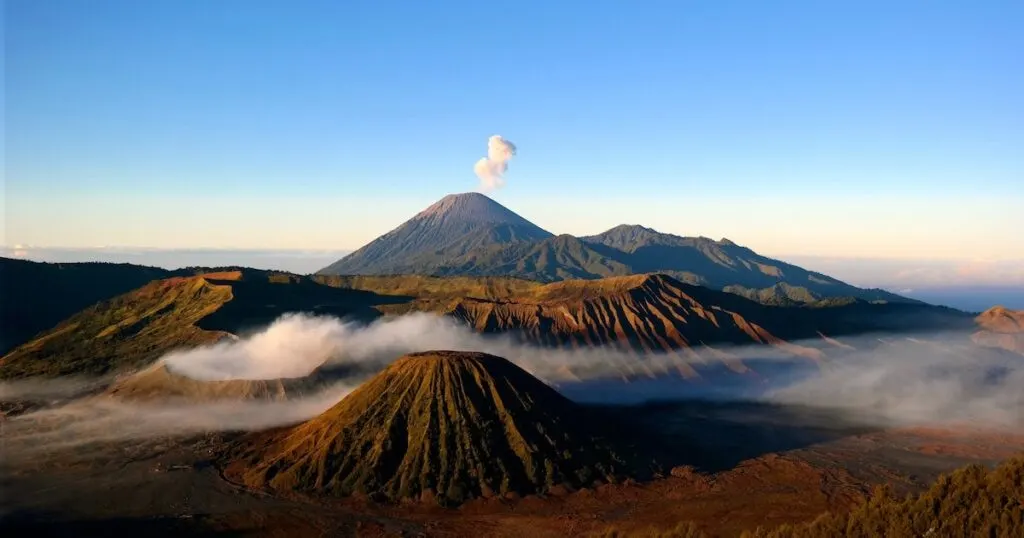
Java is an Indonesian island immediately south of Sumatra, accessible by a flight or ferry, and a great choice after backpacking Sumatra.
Like Sumatra, it’s speckled with volcanoes. It’s home to the capital of Indonesia, Jakarta, but the most famous things on the tourist map are Mount Bromo, crater volcano, and Mount Ijen, which spits out what has become known as ‘blue fire’ on the south of the island (close to west Bali).
Yogyakarta’s temples are also world-renowned.
3. Singapore
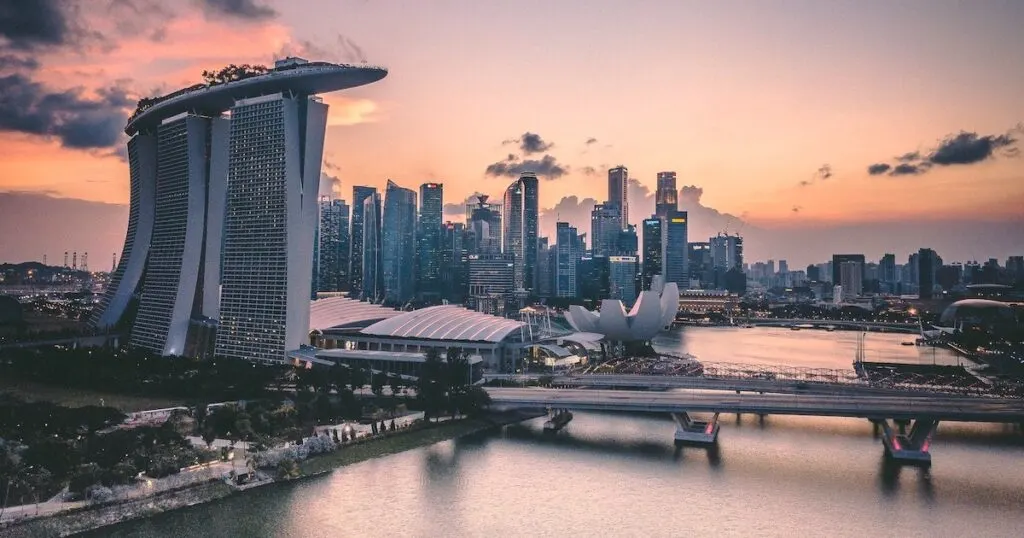
Singapore, one of the cleanest cities in Asia, is a short flight away. Its skyline is one of the most famous in the world, especially the Marina Bay Sands and Gardens By The Bay.
Dine on local food in the hawker markets and soak up the green spaces, such as the botanical gardens. There are museums, a theme park, temples, and a reel of other things to see.
FAQ
While Sumatra does not have a backpacking trail, it is a great destination for backpackers who want authentic local experiences and enjoy hiking, natural scenery, and wildlife. The island has volcanoes, crater lakes, valleys, and canyons, as well as Sumatran orangutans and other indigenous species.
The most beautiful island in Sumatra is widely regarded to be the Mentawai Islands, a group of islands covered in palm trees and remote beaches. Surf camps are popular on the Mentawai Islands.
The crime rate in Sumatra is very low. In 2020, there were 150 crimes recorded per 100,000 people.
The average temperature in Sumatra is 32 °C. The temperature is consistently hot and humid all year round.
The southernmost point of Sumatra is a short ferry journey from the north of Java. If you’re travelling from Medan to Jakarta, however, the flight covers over 1,800 kilometres.
Sumatra is a developing country with rural and urban poverty. Wealth is distributed unevenly, with very few benefitting from the island’s oil fields, coalfields, gold and silver.
Sumatra is located in the Ring of Fire, so it is considered to be prone to natural disasters such as volcano eruptions, earthquakes and tsunamis. The crime late is low. Overall, Sumatra is safe as long as you know the proper precautions to take in the event of a natural disaster.
A flight from Denpasar in Bali to Medan in Sumatra takes approximately three to four hours non-stop.
Most people consider Sumatra to have better scenery and wildlife than Java. However, Java is appreciated for its culture and temples. There are orangutans in Sumatra, but not in Java.
AUTHOR
Katie Treharne
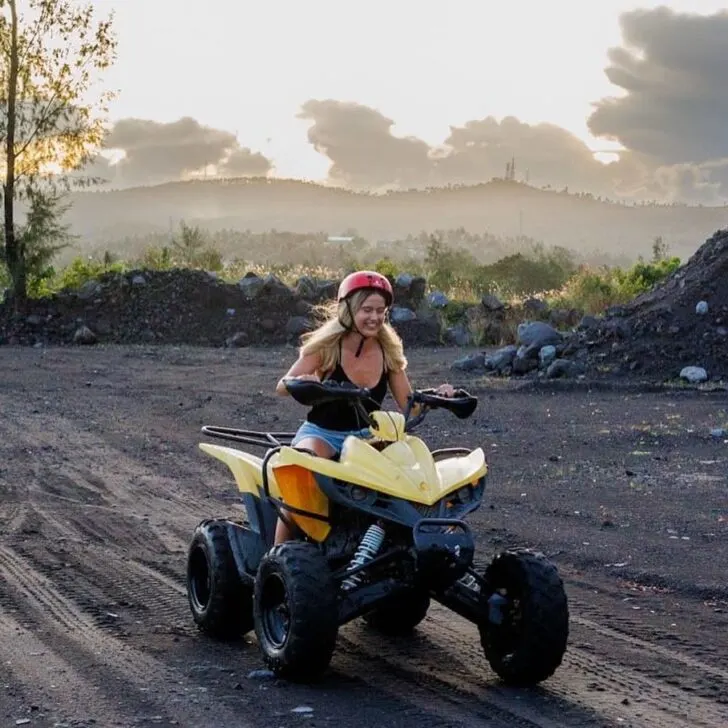
I’m Katie, the owner of Escape Artist Katie. I have been travel writing since 2018, including writing for luxury travel magazines and publications such as Wanderlust.
As well as being a digital nomad who works and lives abroad permanently, I’m a big advocate for offbeat travel and pushing yourself out of your comfort zone.
I hope you found my article useful – find out more about me here or keep up with my travels on Instagram.

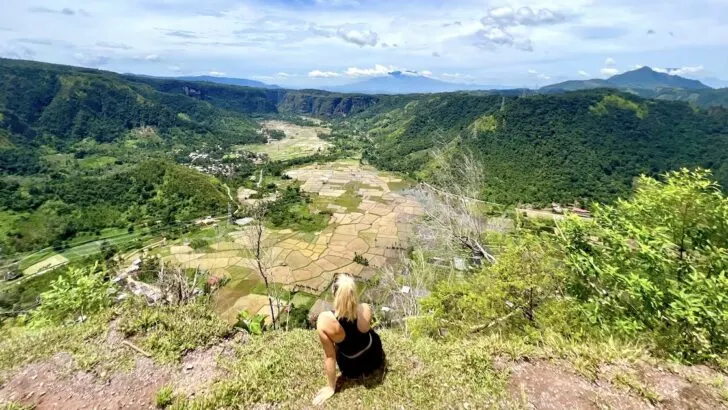
Niraj Patel
Monday 25th of March 2024
Hi Katie Amazing blog! Thank you so much
I wanted to spend 3 weeks backpacking in Sumatra with my wife and 14 and 12 year old. Due to their summer vacation we can only go in June.
Do you think travel during the "burning season" is bad enough to change our travel destination? Thank you
Janet D.
Monday 19th of February 2024
Thank you Katie! I was planning on going to Sumatra to begin my indonesian trip. But unfortunately, I could only go in September and had no idea about the burning season. Therefore, I will not visit Sumatra. You are the only in depth blog on Sumatra that I've found. So thank you!!!
Friday 12th of January 2024
Loved this blog thank you, so informative.
I am a Deaf Solo Traveller.
My “priveleged” dilemma is which trek/company to use for the orang utans jungle activity. I want to do something ethical here, but need to feel safe. Perhaps you can give me a couple suggestions?
Arriving Medan on 21st January. I see it is wet season from your blog, and am slightly worried! Assume its not like raining all day everyday when its wet season?! Sorry to sound naive here.
With thanks Tyron
Tyron
Friday 12th of January 2024
Forgot to add my contact!
Larry
Friday 13th of October 2023
Hello Katie...thanks for the thorough post! I was in Sumatra in 2010 and am heading back in January. I'm planning to fly to Padang and then slowly work my way to Lake Toba. From Bukittinggi onward, I don't really know much about the country on the way to Lake Toba? Any recommendations for that stretch? Thank you and enjoy your travels!
escapeartistkatie
Friday 13th of October 2023
Hi Larry! Have a brilliant trip. I also started my trip in Padang. In Western Sumatra, I'd highly recommend visiting Padang, Mentawai Islands (if you have time), Harau Valley, Maninjau Lake, and Sikabu (they are all quite accessible from Bukittinggi). After speaking to locals about the areas between Bukittinggi and Lake Toba, I decided against making any stops due to time constraints. Nias Island is the main place - it requires a small detour. Sipirok is around halfway too - locals told me that this area has some guesthouses and it's mainly popular for trekking and waterfalls.